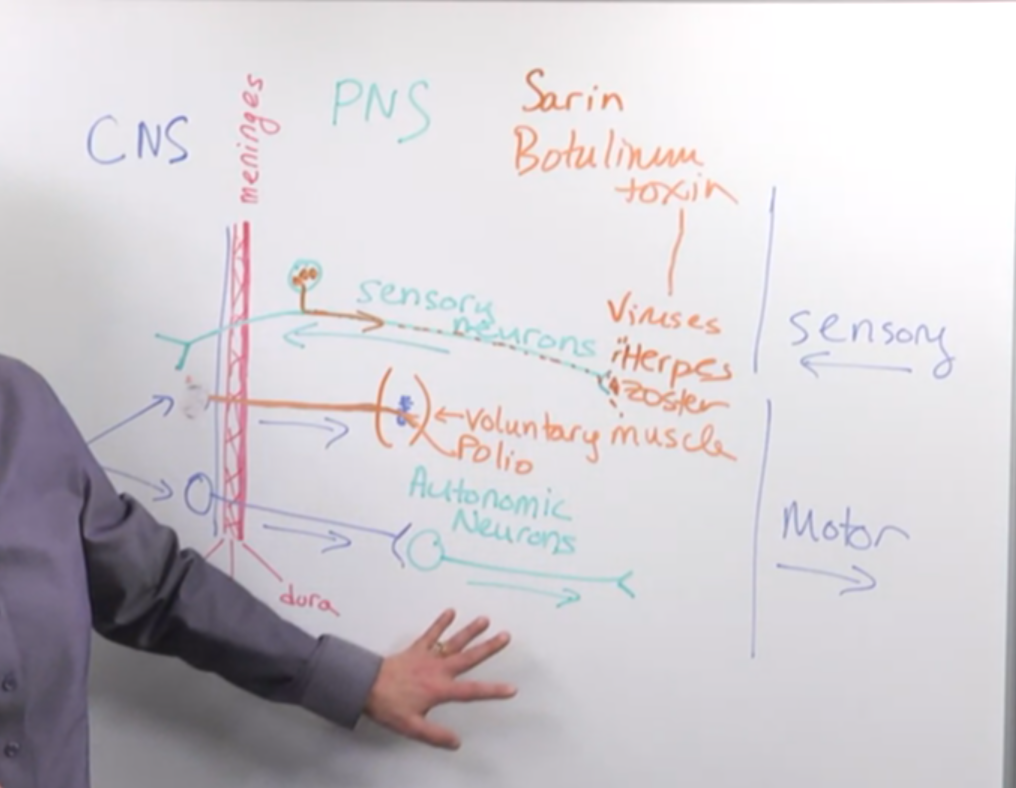 Key Ideas:
Key Ideas:
-
Structure of the Meninges:
- The meninges are three layers of membranes that form a barrier between the central nervous system (CNS) and the peripheral nervous system (PNS).
- The layers include the pia mater (closest to the CNS), the arachnoid mater, and the dura mater (farthest from the CNS), which is tough and protective.
-
Role of the Meninges:
- The dura mater acts as a protective sack, preventing the brain from sustaining injuries like concussions by floating it in cerebrospinal fluid.
- The meninges provide structural support and protect the CNS from physical damage.
-
Neuronal Distribution:
- Nearly all neurons in the CNS are contained within the meninges, except for motor neurons that exit the CNS to innervate peripheral tissues.
- Motor neurons in the PNS control voluntary skeletal muscle movement and autonomic functions such as gland secretion and cardiac muscle activity.
-
Peripheral Neurons:
- Peripheral neurons include sensory neurons and autonomic neurons, which are located outside the CNS and transmit information to and from it.
- Neurons are categorized as peripheral or central based on the location of their cell bodies rather than the location of their axons or dendrites.
-
Shared Vulnerabilities:
- Peripheral neurons share vulnerabilities with each other due to their location outside the CNS, making them susceptible to certain disorders.
- For example, congenital insensitivity to pain results from mutations affecting sensory neurons that respond to injury, as well as autonomic neurons responsible for sweating.
-
Understanding Diseases:
- Diseases affecting either the CNS or the PNS often exhibit distinct symptoms based on the affected neuronal populations.
- Exploring these diseases provides insights into the complexities of neural development and function in both the central and peripheral nervous systems.
Key Ideas:
-
Difference Between Central and Peripheral Nervous System Vulnerability:
- Diseases affecting the nervous system typically target either the central nervous system (CNS) or the peripheral nervous system (PNS), rarely affecting both.
- The meninges act as a barrier protecting the CNS from toxins, viruses, and damage, making the PNS more vulnerable to external threats.
-
- The PNS has a greater capacity for repair compared to the CNS. Axonal injuries in the PNS can often repair themselves, while traumatic injuries to the CNS generally do not heal.
-
Vulnerabilities of the Peripheral Nervous System:
- The PNS is vulnerable to toxins like botulinum toxin, which primarily affects peripheral neurons but cannot breach the meninges.
- Viruses such as polio and herpes zoster exploit different mechanisms to infiltrate peripheral neurons, causing diseases like polio-induced paralysis and shingles.
-
Examples of Viral Infections:
- Polio virus enters through the synapse between motor neurons and voluntary muscles, ultimately causing motor neuron death and muscle weakness.
- Herpes zoster virus, responsible for shingles, infects sensory neurons, remaining dormant until reactivation, which can lead to a painful rash in the affected dermatome.
-
Unique Characteristics of Shingles:
- Shingles typically manifests as a rash localized to one side of the body, following the sensory distribution of the affected neurons.
- The distribution of shingles often corresponds to specific nerve pathways, such as the ophthalmic division of the trigeminal nerve.
-
Effects of Toxins:
- Toxins like sarin primarily affect the PNS due to their inability to penetrate the CNS, causing peripheral nerve damage without directly impacting the brain or spinal cord.
-
Future Topic: Brain Tumors:
- The next segment will explore brain tumors, shifting the focus to disorders affecting the CNS.
